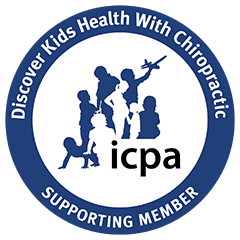How Chiropractic Offers a Foundation for Enhancing the Nervous System
Some concepts have existed for so long that it’s difficult to know where they came from. The American Heritage Dictionary defines “The Sixth Sense” as a power of perception seemingly independent of the five senses; keen intuition. So how does the sixth sense tie in to pregnancy?
The Senses
A lot of people feel that the sixth sense is too “out there” to be grounded in scientific fact. Most people recognize the five senses of sight, hearing, touch, taste, and smell because they are tangible. In neurology they are grouped together as the “far” senses, elemental for perception of the outside world.
On the other hand, I spend a lot of time talking about the “near” senses to parents in my office. These are three other senses that get less popular press but are by no means less important: The vestibular sense, which keeps us balanced and upright. Proprioception, which lets us know where our body parts are at any given point in time. And interoception, which tells us when our stomachs are empty and our bladders are full. These “near” senses give the brain information about our inner worlds.
Not only do we see measurable changes in the “near” senses, such as improved balance for adults, but chiropractic care seems to have an organizing influence on all three as children grow from babies to 2nd graders. It was while listening to my colleague, Dr. Drew Rubin, discuss the neurology of pediatric chiropractic when I realized that the “Sixth Sense” is real, it’s measurable, and
if it isn’t working well, chiropractic may provide a pathway to improving it.
Polyvagal Theory
Dr. Rubin was talking about polyvagal theory, a theory developed by Dr. Stephen Porges. This theory shows that there is a newer aspect to the autonomic portion of the nervous system. This shows the nervous system goes beyond fighting, fleeing, or freezing when confronted with a stressor. Unlike the sympathetic “fight or flight” and the parasympathetic “freeze” response, the social vagus responds to stress by giving, receiving, and asking for help. The vagus nerve is the unifying neurological structure in the body for social, sympathetic and parasympathetic threat assessments. We can measure the vagus nerve’s adaptability, flexibility, and resilience using Heart Rate Variability (HRV). Many chiropractors use HRV in practice.
Crazy enough, chiropractors have been early adopters of the technologies that measure HRV. Chiropractors have published research describing how HRV readings improve after adjustments. It is almost as if we’ve found ourselves in a positive feedback loop of chiropractic care validating HRV research on the autonomic nervous system, and polyvagal theory providing a solid backing for the application of chiropractic care.
New Insight
Nearly a decade ago, I began surveying my pregnant and postnatal patients’ quality of life with a tool developed by the National Institute of Health called the PROMIS-29. We ran some basic statistics and saw a correlation between physical symptoms and mental health scores. I heard my colleague Dr. Ian Shtulman once say that if chiropractic suffers from anything, it is its simplicity. How can realigning a bone or vertebra impact our thoughts or feelings? The answer for us is because it restores normal “tone,” what
Dr. Porges calls “tune,” and more directly, it induces harmony between the signals of the brain and body.
System Check In
Just like any instrument that needs to be calibrated to make sure it’s running smoothly, the nervous system benefits from someone who knows a thing or two about its optimal function, to assure the body’s check engine light doesn’t get ignored and lead to problems. The purpose of neuroception is to appropriately scan the environment to keep you on your destined path of well-being. It is also to alert
you if you’re in danger.
That check engine light—that tiny voice of intuitive wisdom that has been stored deeply in the recesses of your ancestral DNA—has evolved to keep each and every one of your predecessors aligned and safe. Our ancestors were able to listen and respond to it, making it possible for you to be here today. Nowadays, we have a hundred emails, plus a hundred Facebook notifications, fear inducing stories and 24-hour news cycles, car lines and high fructose corn syrup, BPA, and and pandemic shutdowns, and trending hashtags, and, and, and… all drowning out our sixth sense.
A New Time of Birthing
During the restrictive national lockdowns, birthing couples were scared. Not only did I see those pregnancies in practice, but I was part of one myself. I got to see the frontlines of hypnobirthing classes move to virtual. I listened to patients cry to me after being bullied by doctors who were making things up as they went. Among other alarming rises, there was a surge in the number of breech pregnancies. One homebirth midwife helped explain that “In times of stress or turmoil, sometimes babies just want their heads closest to their mommy’s hearts.” I don’t know if truer polyvagal words were ever spoken. I’d be willing to bet Dr. Porges would agree.
A Path Forward
As chiropractors, we work as collaborators to improve accessibility to a patient’s neurology by making them feel safe and curious. As a profession, chiropractors get high customer service marks for being good listeners and are obsessive about educating our clients. Some of us study special techniques to safely care for pregnant patients. Most of us encourage autonomous thinking in healthcare. We are often the first providers to tell parents-to-be that they have a lot of choices in front of them when it comes to pregnancy, birth, and family well-being. Our practice members trust us because we’re like the nerdy, crunchy, kind of maverick friend who cheerfully answers a text at 2AM when you’re in labor.
In Summary
I think our pathway through the challenges of the current healthcare environment comes through chiropractic. More families and pregnant women need to understand that the higher purpose of adjustments isn’t merely to relieve back pain. It is to seek out clinics and professionals whose mission is to support their nervous systems on all levels. Importantly, we as a profession have been getting ready for these women. aking on the responsibility of learning how to serve this population in a measurable, meaningful way. Polyvagal-informed chiropractors are out there and are waiting to recruit the collective nervous system on a shared journey toward wellness.
John Edwards, DC, DACCP
Appears in Pathways to
Family Wellness Magazine Issue #74
Provided and published by ICPA. For more information, visit discoverkidshealth.com
Learn more about the benefits of chiropractic care and the benefits of making it part of your family’s wellness lifestyle. Click to schedule a complimentary consultation with the Body & Balance practitioners today.



